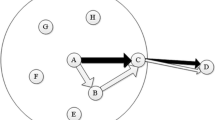Abstract
Sensor networks using mobile robots have recently been proposed to deal with data communication in disruption tolerant networks (DTNs) where an instantaneous end-to-end path between a source and destination may not exist. In such network scenarios, a node should move to deliver data to the destination. In this paper, we study adaptive formations of mobile robots based on the knowledge of network topology held by each node. Different node formations are applied when nodes have neighboring, clustering, or perfect information of network. Node formations also depend on traffic patterns, e.g., single and multiples packets per event. We introduce a straight line formation called pipeline for delivering multiple packets continuously. The benefit of controlled mobility in DTNs is validated through the ns–2 simulation tool by comparing with the ideal cases.
Preview
Unable to display preview. Download preview PDF.
Similar content being viewed by others
References
Vahdat, A., Becker, D.: Epidemic routing for partially-connected ad hoc networks. Technical Report CS-2000-06, Duke University (July 2000)
Zhao, W., Ammar, M., Zegura, E.: A message ferrying approach for data delivery in sparse mobile ad hoc networks. In: Proceedings of MobiHoc, pp. 187–198 (May 2004)
Thepvilojanapong, N., Tobe, Y., Sezaki, K.: Impact of intentional mobility in sparse sensor networks. In: Proceedings of SenSys, pp. 286–287 (November 2005)
Karp, B., Kung, H.T.: GPSR: greedy perimeter stateless routing for wireless networks. In: Proceedings of MobiCom, Boston, MA, USA, pp. 243–254 (August 2000)
Beaufour, A., Leopold, M., Bonnet, P.: Smart-tag based data dissemination. In: Proceedings of WSNA, pp. 68–77 (September 2002)
Shah, R.C., et al.: Data mules: Modeling a three-tier architecture for sparse sensor networks. In: Proceedings of SNPA, pp. 30–41 (May 2003)
Jain, S., et al.: Exploiting mobility for energy efficient data collection in sensor networks. In: Proceedings of WiOpt (March 2004)
Goldenberg, D.K., Lin, J., Morse, A.S.: Towards mobility as a network control primitive. In: Proceedings of MobiHoc, pp. 163–174 (May 2004)
Small, T., Haas, Z.J.: The shared wireless infostation model: a new ad hoc networking paradigm (or where there is a whale, there is a way). In: Proceedings of MobiHoc, pp. 233–244 (June 2003)
Fall, K.: A delay-tolerant network architecture for challenged internets. In: Proceedings of SIGCOMM, Karlsruhe, Germany, pp. 27–34 (August 2003)
Jain, S., Fall, K., Patra, R.: Routing in a delay tolerant network. In: Proceedings of SIGCOMM, Portland, Oregon, USA, pp. 145–158 (August 2004)
Intanagonwiwat, C., Govindan, R., Estrin, D.: Directed diffusion: a scalable and robust communication paradigm for sensor networks. In: Proceedings of MobiCom, Boston, Massachusetts, USA, pp. 56–67 (August 2000)
Author information
Authors and Affiliations
Editor information
Rights and permissions
Copyright information
© 2007 Springer-Verlag Berlin Heidelberg
About this paper
Cite this paper
Sezaki, K., Thepvilojanapong, N., Tobe, Y. (2007). Mobility Helps Data Delivery in Disruption Tolerant Networks. In: Ichikawa, H., Cho, WD., Satoh, I., Youn, H.Y. (eds) Ubiquitous Computing Systems. UCS 2007. Lecture Notes in Computer Science, vol 4836. Springer, Berlin, Heidelberg. https://doi.org/10.1007/978-3-540-76772-5_24
Download citation
DOI: https://doi.org/10.1007/978-3-540-76772-5_24
Publisher Name: Springer, Berlin, Heidelberg
Print ISBN: 978-3-540-76771-8
Online ISBN: 978-3-540-76772-5
eBook Packages: Computer ScienceComputer Science (R0)




